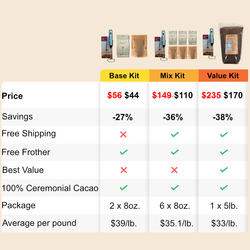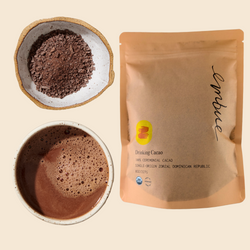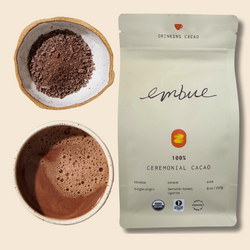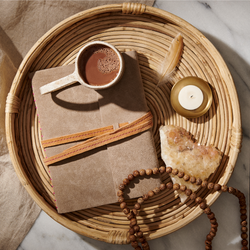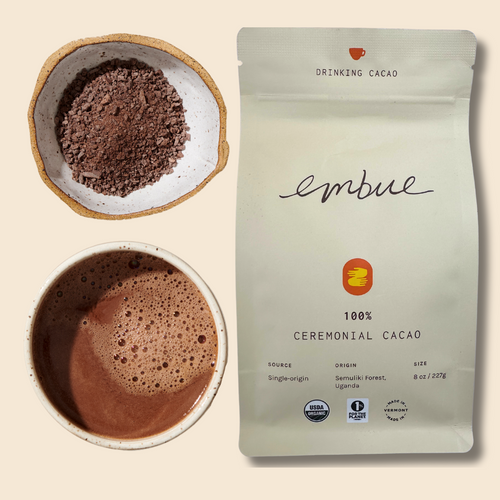The Importance of Certified Organic Cacao
Since we started working with ceremonial cacao and sourcing it for others to use, we’ve always wanted to ensure that it’s both the highest quality and has a positive impact. Because of this, we’ve always strived to use certified organic cacao, and as soon as we were able to complete the certification process, we did. It's a no-brainer for us in wanting to maximize the positive impact we have in our sourcing, both at the origin for the farmers and the land, as well as for you, the end consumer. We believe it’s essential for ceremonial cacao to meet the highest standards, and certified organic is one of those.
While it’s nice to imagine that small-scale farmers don’t want to use chemicals or can’t afford them, this “defacto organic” claim offers little transparency or insight into what happens on the farm. The reality for farmers and farming families is that their livelihoods are on the line, and with the abundance of pests & diseases that can decimate a cacao crop, the incentive is to use whatever means necessary to bring a crop to market. We believe that it’s essential to know exactly what’s happening on the farms where cacao is grown, instead of relying on the hope that cacao is always naturally grown.
Organic growing practices are important for 4 main reasons:
- 1. The health of soil, air & water
- 2. The health of plants, animals & insects
- 3. The health of farmers & their families
- 4. Your health
While organic growing practices don’t guarantee high-quality cacao, they certainly give us peace of mind in knowing that something we’re regularly consuming hasn’t adversely affected the health of local ecosystems, farmers, and our own bodies.
A little-known fact is that cacao production is among the heaviest users of chemical pesticides, herbicides & fertilizers, right up there with cotton production. “Between 75 and 96 percent of cocoa farmers in West Africa - the world's most important cocoa-growing region - now use these pesticides to control pests” (Source)
A University of Chicago/NORC study found in West Africa that over the last 10 years, pesticide & herbicide use has increased by 20%, and use of fertilizers by 10%. (Source).
This reality means that when researchers have tested conventional cocoa beans, they have found chemical residue. (Source 1, Source 2). While it’s claimed that the residue is below acceptable levels, we see no reason to take that risk.
The organochlorine pesticide residues that are found are a class of synthetic pesticides that have a known negative effect. They have a high toxicity, slow degradation rate, and are known to bioaccumulate through the food chain. Many organochlorine molecules are known carcinogens and neurotoxins, among other health concerns to humans. Their disruption to ecosystems is also well documented. (Source)
To make matters worse for farmers and the land at origin, there are large differences between chemical products that are approved for use in North America/Europe and those used in cacao-growing regions. Laxer laws have left more toxic chemicals in circulation, and lower standards of application mean that the impact on farmers is even greater.
“Compliance with national pesticide regulations is insufficiently controlled in cocoa-growing countries. As a result, banned and counterfeit products find their way into cocoa communities. In addition, pesticide regulations in the growing countries are often weaker than in many European countries. What few chocolate lovers know: The majority of these pesticides and the active ingredients used in cocoa farming are banned in Europe due to their hazardous health risks to people and the environment.”(Source)
Climate change is also exacerbating this problem as it has increased the risk of crop loss due to pests & disease. A changing climate has created more instability and one short-term way to mitigate that is to use chemicals to save a crop.
In contrast, to farm organically means approaching the land more holistically. Without quick fixes, integrated practices with a long-term vision are needed. At our origins, they use an agroforestry approach, with intercropping of other value-added crops, such as banana, palm, citrus, and timber. They’ve used this approach to create a buffer zone around a pristine cenote lake, that promotes forest cover, soil, and riverbank conservation. This is a win-win, as it creates long-term health for the land & the farmers, and increases their resilience through varied income sources. For smallholder farms, that makes a big difference.
The term organic is a legally controlled term and requires a rigorous verification process to ensure compliance both at the farm and in the chocolate shop. It means none of the ingredients can be GMO and that there is traceability from start to finish. This is why we believe ceremonial cacao should be certified organic. It’s a guarantee that doesn’t leave any uncertainty about what exactly is happening at the origin. It supports farmers in making healthy choices that are good for them, for the planet, and for us as final consumers.
